
SKODA Octavia Combi RS
Generations Timeline, Specs and Pictures

The Czech carmaker Skoda just turned its sportiest model towards the electricity avenue with the fourth generation of its performance model, the Octavia vRS.
They even called it iV, instead of a simple 4th or IV. And it is not just a hybrid, it is a plug-in hybrid. It is the kind of vehicle that might steer petrolheads towards electric mobility.
The first three generations of the Octavia vRS were mostly gasoline turbocharged engines and it was a cheaper alternative for hot-hatches, but packed into a more practical bodywork. Now it is not that cheap anymore, but it is more practical. Under the hood, Skoda installed a 1.4-liter TSI engine that offers 150 hp. On top of that, an electric motor of 85 kW helps things up obtaining a total combined output of 245 hp and 400 Nm (295 lb-ft) of torque.
Transmission is on the front wheels only via a 6-speed DSG (double-clutch) gearbox. But the performance numbers are not so impressive. Actually, since it is a plug-in hybrid and it is heavier than the previous generation, it is much slower. The 0-100 kph (0-62 mph) sprint is obtained now in 7.3 seconds, compared with 6.8 seconds for the former generation. The top speed now is 225 kph (140 mph), which is 25 kph (15.5 mph) slower than the Octavia vRS from the 3rd generation. But it is more fuel-efficient. If that will count for a petrolhead.
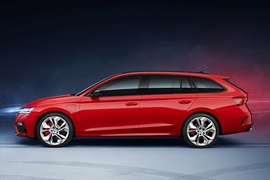
Since the 2020 Geneva Motor Show was canceled, the Czech carmaker chose to show its newest products online.
Besides the claimed new top-performer Octavia vRS iV, the Combi version was shown too. It has the same powerplant under the hood, consisting of a 1.4-liter TSI gasoline engine and an electric 85kW motor. The plug-in hybrid has a combined power output of 245 hp and 400 Nm (295 lb-ft) of torque.
Inside, there is more headroom for the rear passengers and more trunk-space than the sedan version. It has 490 liters, which is more than the sedan vRS, but it is smaller than the third generation. The new vRS has the car’s battery inside the trunk. Another downside is the performance factor. The previous generation of the RS was quicker. Even the current generation of the regular Octavia has two versions that are quicker than the vRS. The 190 hp 2.0-liter TSI version can do the 0-100 kph (0-62 mph) sprint in 6.9 seconds, compared to the 7.3 seconds needed by the vRS. Even the 2.0 TDI is faster, with 7.1 seconds needed for the same sprint.
But, after all, the new vRS is aiming at people who are more eco-friendly and want electrified vehicles without giving up on performance.
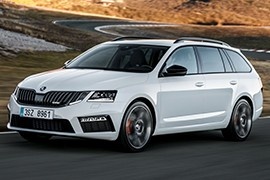
The refreshed third generation Skoda Octavia Combi also got an RS version, with its dynamic character that is noticeable at first glance.
The front end comes with a grille that is enhanced by additional full-LED headlights with adaptive frontlight system, and a sport bumper with large air intakes. The wing mirrors and door handles of the Skoda Octavia RS and the Skoda Octavia Combi RS have the same colour finish as the body. For the sporty top-of-the-range model a choice of eleven colours is available, including the special colours ‘Steel Grey’ and ‘Rally Green’. In addition, customers can also opt for the ‘Black Design’ style pack. On the tailgate, the spoiler lip (hatchback) or the roof spoiler (Combi) create design accents. With its new shape, the rear bumper appears powerful and neat thanks to subtle contours. There is a choice of two high-performance, four-cylinder turbo engines for the intensively revised Skoda Octavia RS and Skoda Octavia Combi RS - one petrol and one diesel.
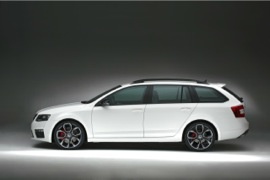
After the successful range of vRS vehicles offered by Skoda, the Czech car-maker decided to build a station-wagon with the same engines and features.
It was unveiled at the Goodwood Festival of Speed in 2013.
Some parents want a vehicle suit for the entire family but, once the other family members were dropped to schools or jobs, the rest of the road might be driven faster. The station-wagon vRS was exactly that kind of vehicle, with a powerful engine for the size of the car. A hot-hatch trapped into a station-wagon body. That was the third generation of the Octavia RS Combi, with sporty-looking wheels, a roof-spoiler in the back, and an aggressive front bumper and apron. It was the most powerful and fastest Skoda ever built, at the time of its launch.
Inside, there was enough room for five passengers, but it featured front bucket-seats with high bolsters good for fast cornering. The dashboard and the instrument cluster was common with other Octavia models, but the steering wheel was different, with grippier zones for thumbs. The aluminum pedals completed the sporty image of the car.
Under the hood, the Octavia RS station-wagon was offered with a choice of two engines: 2.0-liter turbocharged gasoline or a 2.0-liter turbocharged diesel engine. Both versions were fitted as standard with a 6-speed manual, but a 6-speed automatic DSG (dual-clutch) was on the options list.
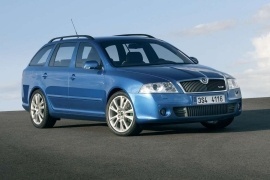
The first generation of the Octavia RS was a well-deserved success, and the Czech carmaker insisted on producing a successor for it in both shapes: hatchback and station wagon.
Skoda introduced the second generation of the Octavia in 2004, and it was a car worth waiting for the European customers. It offered compact-segment pricing, mid-size segment interior space, and the trusted Volkswagen reliability. For those who needed a bigger trunk, the carmaker offered it in a station wagon shape as well. Then, in 2005, it added a spicy RS seasoning for driver’s delight.
While other carmakers tried to make their hot-hatches look more aggressive, Skoda had another idea: make the car subtle. The RS version didn’t feature any aggressive front bumpers, big wings in the back, or wider wheel fenders. The only specific visible features were the VRS badge on the grille, its 17” light-alloy wheels, and a double exhaust in the back. It was not bland; it was subtle.
Inside, there was a different story. First of all, the RS, chromed, door-sills welcomed the passengers. As an option, the carmaker offered a set of sport bucket-seats with the VRS logo embroidered on the front’s backseats. The Octavia II RS Combi featured a 580 liters (20.5 cu-ft) trunk size that could be expanded up to a staggering, for its class, 1,620 liters (67.8 cu-ft) by completely folding down the rear bench.
Under the hood, Skoda dropped a Volkswagen Golf GTI engine paired to a six-speed manual or, as an option, to a six-speed automatic. The carmaker also offered a fuel-efficient turbo-diesel version that pumped out 258 lb-ft (350 Nm) of torque.
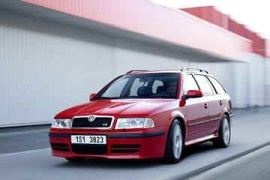
Skoda introduced a station-wagon version for the Octavia RS in 2002 and transformed its fastback sedan into a fast family carrier, with one of the biggest trunks in its class.
Since Skoda built the Octavia on the same platform as the Volkswagen Golf, it was easy for the Czech carmaker to drop a sporty drivetrain into the engine bay. All it needed was approval from Volkswagen Group. Thus, in 2001, the Czech brand presented the RS as a five-door fastback and in 2002, the station-wagon.
The Octavia vRS was considered a poor’s man GTI. It offered plenty of features for a family and a hot-hatch engine under the hood, and that was noticeable on the car’s exterior. The carmaker installed a new front bumper with an apron and a wider grille at the bottom. From its sides, the unique light-alloy wheels design made a clear difference when compared with the rest of the range. On top of the tailgate, Skoda installed a roof-spoiler designed especially for the Octavia RS Combi.
Inside, the carmaker mounted sport bucket-seats with high bolstering to ensure a better grip for the driver and the front passengers during high-speed cornering. Its two-tone interior was unique for the vRS version, and its standard features list was longer than on the regular Octavia. Though, the heated seats and the ESP were on the options list.
Under the hood, Skoda installed a 1.8-liter turbocharged gasoline engine paired as standard to a five-speed manual and sent its power to the front wheels only. Still, the car featured stiffened suspension, bigger brakes, and independent suspension in all corners.























































